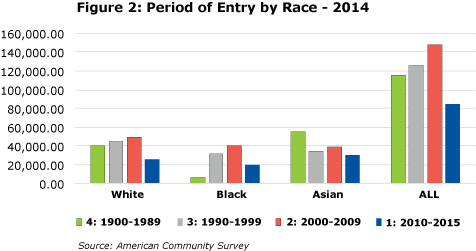by Amanda Rohrer
March 2016
Minnesota historically has been less diverse than most other states, but that is beginning to change because of immigration.
Because of our geographic expanse and history, the United States has been diverse for most of its history. But how we've defined and measured that diversity has changed with the cultural winds.
The earliest censuses didn't record race – only gender and whether a person was free or a slave. By 1820, the census asked about citizenship status. In 1850 the census first asked about race, but the only categories were white, black and mulatto. In 1870 categories were added for Chinese and American Indian.
As the decades progressed, additional categories were added, but most of the race categories remained what we now consider nationalities. In 1930 the options were white, black, Mexican, American Indian, Chinese, Japanese, Filipino, Hindu and Korean, with additional options to be written in. Distinguishing race, ethnicity and nationality was the next major overhaul, as part of the American Community Survey (ACS) after the 2000 census.
Historically, race has been a means of grouping people who share a set of characteristics. It's a nebulous concept because the common traits of the group may be based on religion or country of origin or a shared experience, such as being the target of segregation, rather than color.
The way the census currently measures these traits – by using a set of variables instead of a single variable indicating very specific "races" such as Chinese and Japanese – allows for much more precision. But it can complicate analyses. Comparing the Asian population across states assumes that all Asians have a common experience in the U.S., regardless of nationality or immigration status. There is a diversity of backgrounds and experiences in every race in the U.S., and those should be taken into account in any analysis that uses race as a dimension.
By the available measures, Minnesota historically has been less diverse than most of the rest of the country. In 1980 Minnesota was in the top five states for the predominance of the white population, with 97.9 percent white compared to 86.3 percent nationally. How race is tracked has changed but now Minnesota is closer to the middle of the pack, ranked 13th (see Table 1). While the differences in how we measure race are significant enough that the percentages are not directly comparable, Minnesota is becoming substantially more diverse, and much of that change has occurred in the last few decades and at a fairly rapid pace.
| Share White in 2014, Top 15 and Bottom 5 States by Rank, Total Population (ACS) | ||
|---|---|---|
| State | Percent Non-Hispanic White | Rank |
| Maine | 93.7 | 1 |
| Vermont | 93.2 | 2 |
| West Virginia | 92.6 | 3 |
| New Hampshire | 91.2 | 4 |
| Iowa | 87.1 | 5 |
| North Dakota | 86.8 | 6 |
| Montana | 86.7 | 7 |
| Kentucky | 85.4 | 8 |
| Wyoming | 84.0 | 9 |
| South Dakota | 83.2 | 10 |
| Idaho | 82.8 | 11 |
| Wisconsin | 82.2 | 12 |
| Minnesota | 81.3 | 13 |
| Nebraska | 80.4 | 14 |
| Indiana | 80.2 | 15 |
| United States | 61.9 | |
| Nevada | 51.3 | 46 |
| Texas | 43.4 | 47 |
| New Mexico | 38.7 | 48 |
| California | 38.3 | 49 |
| Hawaii | 22.9 | 50 |
| Source: American Community Survey | ||
The change in demographics arose from immigration – both from within the U.S. as people moved from their birthplaces for jobs – and from abroad. In all age groups over 25, the majority of nonwhite and Hispanic Minnesotans were born abroad. For younger Minnesotans, this doesn't hold true, but it's still a larger proportion than the population as a whole.
White people who were born in-state are by far the dominant group in Minnesota. White migrants from other parts of the U.S. make up the second largest group, but they're outnumbered 3 to 1 by people born in Minnesota.
Among other race groupings, the pattern is different. The black population is evenly split three ways between Minnesota-born, U.S. migrants and international immigration. The Asian population is predominantly foreign-born, with few migrants from other parts of the U.S. The Hispanic population is evenly split between local-born and international, with a comparatively small share coming from other states (see Figure 1).

It's worth noting, too, that even though international migration makes up a very small share of the white population, numerically it's still larger than migrants from all other racial and ethnic groups except Asians.
Immigration from abroad tends to come in waves, with different locales serving as the primary source of new immigrants at different times. Based on the period of entry of Minnesota residents in 2014, white immigration has been fairly consistent, black immigration is disproportionately recent and Asian immigration has tapered, although the level still surpasses any other race group (see Figure 2).

Note that a large share of nonwhite immigrants arrived since 1990. This means that new arrivals who have had children contributed to the number of Minnesota-born minorities in younger age groups. These children of foreign immigrants may share some of the language, religious and other cultural characteristics of their foreign-born parents while being counted in the Minnesota-born minority group that they are a part of.
Immigration to Minnesota differs systematically from immigration to the nation as a whole. Compared to the U.S., Minnesotans born abroad are far more likely to be from Africa or Asia than from Latin America. The largest difference is in the African-born population.
Looking more closely at immigration by race showcases just how significant this difference is. All of the other states that have nearly as high a percentage of their black population born abroad are very small and less diverse than Minnesota (Maine, South Dakota and North Dakota). In raw numbers, African immigrants make up a more substantial share of Minnesota's population than these other states. While only 2.6 percent of the U.S. population of black people born abroad lives in Minnesota, most live in very large states and make up a much smaller share of their states' total populations. These states include California, Texas and Illinois.

Immigrants face different challenges than native-born populations. Depending on where they're from and the circumstances of their migration, they may have language barriers, different religious traditions, or education or credentials that are not recognized in the U.S. Financial assets might be more limited, and family and social connections might be less available or more central, depending on the size of the population from that region.
It's important to remember that every race has significant ethnic and cultural diversity. When comparing small populations, the dominant economic characteristics might vary quite a bit even within a race demographic. Understanding the unique traits of the population in a given state can help shed light on some of the differences in labor market experience that statistical summaries cannot provide. These differences should inform the strategies government and social organizations undertake to rectify inequality.